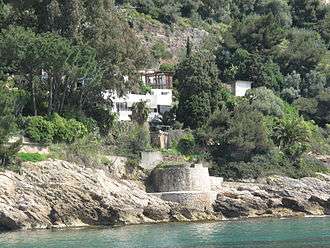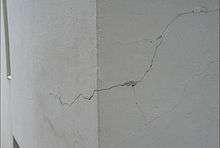E-1027
Coordinates: 43°45′36″N 7°27′47″E / 43.759875°N 7.463186111°E

E-1027 is a modernist villa in Roquebrune-Cap-Martin, in the Alpes-Maritimes department of France. It was designed and built from 1926-29 by the Irish architect and furniture designer Eileen Gray. L-shaped and flat-roofed with floor-to-ceiling windows and a spiral stairway to the guest room, E-1027 was both open and compact. This is considered to be Gray's first major work, making indistinct the border between architecture and decoration, and highly personalized to be in accord with the lifestyle of its intended occupants. The name of the house, E-1027, is a code of Eileen Gray and Jean Badovici, 'E' standing for Eileen, '10' Jean, '2' Badovici, '7' Gray. The encoded name was Eileen Gray's way of showing their relationship as lovers at the time when built.[1]
It is impossible to identify the exact individual contributions of Gray or Badovici to E-1027.[2] Gray also designed furniture for the house, including a tubular steel table which would enable her sister to eat breakfast in bed without leaving crumbs on sheets, due to an adjustable top that caught the crumbs.[2]
Gray and Badovici separated shortly after the completion of the house.[2] Gray began working on a new house, Tempe à Pailla, in nearby Menton in 1931.[2] Tempe à Pailla was furnished by Gray with flexible furniture designed to save space.[2] Only a later house designed by Gray, Lou Pérou in Saint-Tropez, was fully architecturally realized by her.[2]
E-1027 and Le Corbusier
The Swiss born-French Modernist architect Le Corbusier was a friend of Badovici and visited the house several times after Badovici and Gray had parted.[1] While staying as a guest in the house in 1938 and 1939, Le Corbusier painted bright murals on its plain white walls, and sometimes painted in the nude.[1] This intrusion onto her design infuriated Gray, who considered the murals outright vandalism. Whether he painted these murals out of admiration for her work or jealousy of her accomplishment, Le Corbusier became intricately tied with the future of the house. Failing to purchase it himself, he eventually bought a piece of property just east of E-1027, where he built a small, rustic cabin, his Cabanon de vacances.[1] The architecture critic Rowan Moore said of the painting of the murals that "As an act of naked phallocracy, Corbusier's actions are hard to top...", adding that Le Corbusier was "seemingly affronted that a woman could create such a fine work of modernism" so he "asserted his dominion, like a urinating dog, over the territory".[1] Here he would go for work and quiet contemplation, taking daily swims on the beach outside the house. After he died in those very waters, the whole area was declared a "Site Moderne," or "Modern Site," and deemed an area of cultural and historical importance and international interest. Today, E-1027 is recognized as the founding element of this site. Furthermore, Eileen Gray was so slow at putting her name forward as being the architect of the house that for many years it was assumed by many historians and journalists that Le Corbusier was in fact its designer.
E-1027 today
E-1027 is presently undergoing restoration. Gray's original furniture has been removed from the house, and was sold in the early 1990s at the auction house Sotheby's.[1] Replica furniture will be supplied for the house by Zeev Aram, a champion of Gray's work.[1] Plans for its renovation are being prepared by the French government, who have designated it as a French National Cultural Monument. As a result, the state of France and the city of Roquebrune Cap Martin - through the national agency "Conservatoire du littoral" [3] - bought the villa in 1999 and made it secure provisionally. A signboard informs that E-1027 will be restored: the restoration is an initiative of the state of France, the department "Alpes Maritimes" and the city of Roquebrune (expenses to be borne 50% / 10% / 40% respectively).
The house is owned by the Conservatoire du littoral, who have delegated responsibility for it to the local commune of Roquebrune-Cap-Martin.[1] It was the wish of Roquebrune-Cap-Martin that the restoration of E-1027 be managed by the architect Renaud Barres, who had previously produced a study on a possible restoration of the house, and that Barres should work with Burkhardt Rukschcio, an architect who had restored modernist buildings.[1] The French Ministry of Culture wished that the restoration be managed by Pierre-Antoine Gatier, the chief architect for historic monuments in the south of France, who had little experience of modern buildings.[1]
By 2013 the restoration had cost €600,000, and was criticised by Barres and Rukschcio who had produced a "dossier which details, with convincing photographic evidence, departures from Gray's intent: thickening of metal rails, original glazing and light switches replaced by standard 21st-century products, a stair clumsily misplaced and mis-dimensioned, a colour scheme different from the 1929 version."[1] In 2016, the Getty Foundation contributed a $200,000 grant to the ongoing restoration work.[4]


Visits are by guided tour only and for groups of no more than 12 persons.
A biographical film about Gray, The Price of Desire, directed by the Irish film director Mary McGuckian, and starring Shannyn Sossamon and Alanis Morissette, and Vincent Pérez as Le Corbusier, is currently in production.[1] The production of the film has enabled the restoration of certain parts of E-1027.[1]
References
- 1 2 3 4 5 6 7 8 9 10 11 12 13 Rowan Moore (June 30, 2013). "Eileen Gray's E1027 – review". The Guardian. Retrieved June 10, 2014.
- 1 2 3 4 5 6 Rawsthorne, Alice (24 February 2013). "Eileen Gray, Freed From Seclusion". The New York Times.
- ↑ O'Toole, Shane (March 17, 2002). "Eileen Gray: E-1027, Roquebrune Cap Martin". Archiseek. Retrieved February 7, 2012.
- ↑ Deborah Vankin (July 26, 2016), Getty Foundation announces 2016 Keeping It Modern grantees Los Angeles Times
External links
| Wikimedia Commons has media related to Villa E-1027. |
- Eileen Gray. Etoile de mer. Le Corbusier
- Friends of E.1027
- Rukschcio and Barres analysis of recent restoration
- E1027 Iconics design
- Le Corbusier's Role in the Controversy Over Eileen Gray's E.1027
- Eileen Gray, Le Corbusier and E.1027
- Cap Moderne